Thrips, those tiny yet destructive insects that feed on plants, can wreak havoc on your beloved garden. In this article, we explore six telltale signs that indicate you may be dealing with a thrip infestation. By identifying the symptoms of thrips, you can take proactive measures to protect and restore the health of your precious plants.
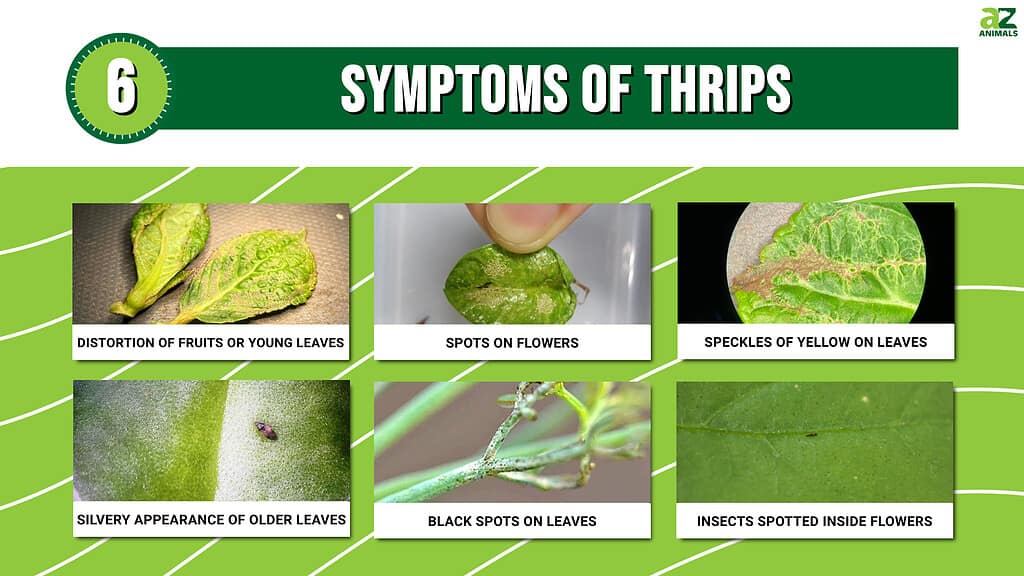
What Are Thrips?
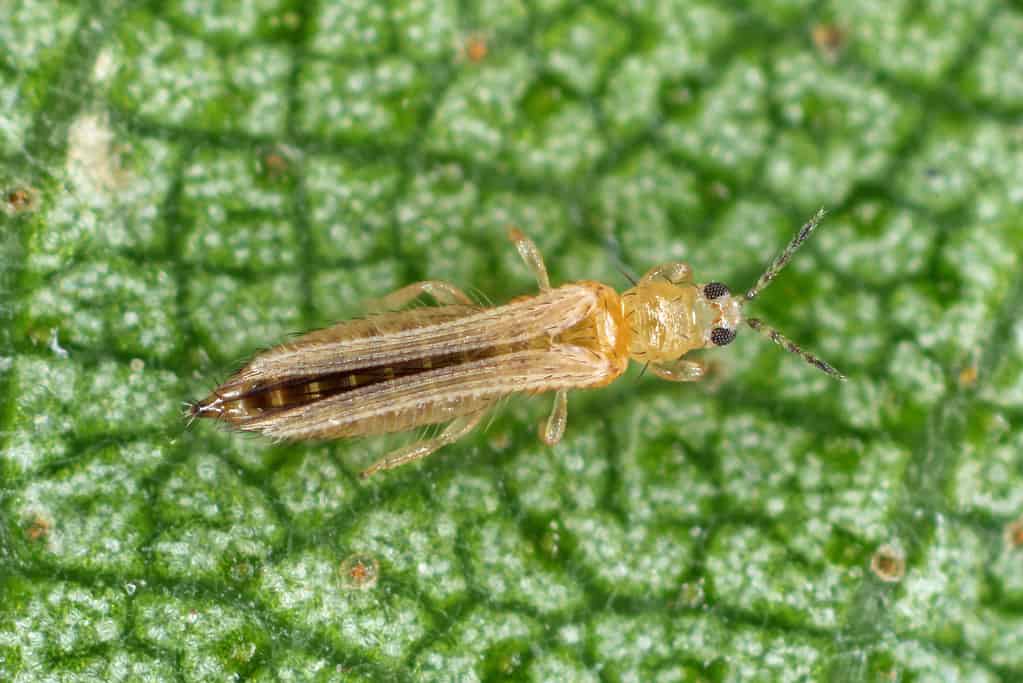
There are different species of thrips to worry about.
©Tomasz Klejdysz/Shutterstock.com
Thrips are tiny, slender insects that measure between 1 and 1.5 mm in length. They have two pairs of wings, with the front pair being narrow and the rear pair being broad. Thrips come in a variety of colors, including black, yellow, and brown. You can tell that your plants are infected by watching for the symptoms of thrips.
What Do Thrips Eat?

Begonias are one of the plants that thrips love to eat.
©Jtaja/Shutterstock.com
Thrips feed on a variety of plants, sucking out the sap and leaving behind small patches of discoloration. They primarily feed on leaves but can also damage flowers, fruits, and vegetables. These insects feed primarily on pollen and fungal spores but may also consume other small insects.
Thrips Lifecycle
Thrips go through four stages of development: egg, larvae, pupa, and adult. Depending on the species, the egg stage can last anywhere from a few days to a few weeks. The larvae stage can last from a few weeks to a few months. During this stage, the thrips feed on plant material and develop wings. The pupa stage lasts for a few days to a few weeks, during which time the thrips do not feed. The adult stage is when thrips are capable of reproducing and can last anywhere from a few weeks to a few months. They are also able to fly when they are adults. They use air currents to float along to a new location.
6 Symptoms of Thrips
Thrips have the ability to puncture the surface of flowers and young leaves and extract the juice from them. Both adult and juvenile thrips inflict damage. As they are often hidden inside the flowers, they can be hard to spot. Here are the common symptoms of thrips.
1. Distortion of Fruits or Young Leaves

Distorted leaves are one common symptom of thrips.
Distorted fruits or young leaves due to thrips damage appear shriveled and curled and may have black or silver patches. The leaves may become brittle and discolored, and the fruits may become distorted in shape or size. The damage may also lead to a dried or silvery appearance on the affected areas.
2. Spots on Flowers

Another common symptom of thrips that you will see is spotted leaves.
Spots on flowers are a common symptom of thrips. They can vary in size and shape but are usually small and round. They are usually a deep brown or black color, and you will see them on both the petals and sepals (the leaves that surround the petals). Thrip spots are caused by tiny insects called thrips, which feed on the flower’s sap and secrete a dark, sticky fluid. This fluid can cause discoloration and wilting of the petals and sepals, and it can also cause the spots to become raised and bumpy. The spots can be irregular in shape and may appear in clusters or in a single line. In some cases, the spots may be accompanied by streaks or webbing, which is caused by the thrips’ feeding habits.
3. Speckles of Yellow on Leaves
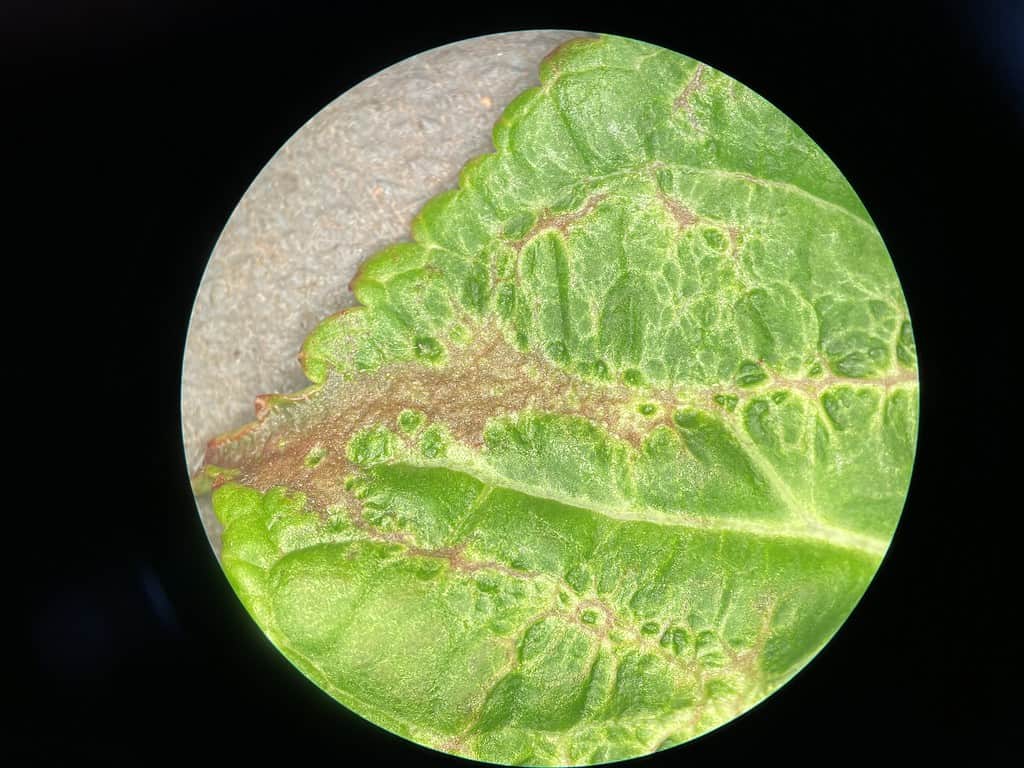
The yellow lines and spots on leaves can be thrip damage.
After thrips damage a plant, you can see the yellow speckles on leaves as small, circular spots. These spots may range from a light yellow to a brighter yellow hue, with some spots appearing to have a burnt-orange color. The spots may have a raised, bumpy texture and appear to be speckled randomly over the leaf’s surface. In some cases, you will see the speckles of yellow spread out from a central point on the leaf, forming a pattern like a starburst.
4. Silvery Appearance of Older Leaves

In this photo, the silvery sheen on the leaf is from thrip damage ( thrip not pictured)
Older leaves can have a distinctive, silvery appearance, which is caused by damage from thrip. The sucking of the thrips causes the leaves to become discolored and distorted. This damage can cause the leaves of older plants to look silvery as if they have been coated with a thin layer of silver. You can see the silvery appearance from a distance, and it is especially noticeable when the leaves catch the light. The damage caused by thrip can weaken the plant over time, making it more prone to other pests and diseases.
5. Black Spots on Leaves

If you notice your plant’s leaves or stems have black spots, that could be thrip poop. Yuk!
©René Total Extension GemüsebauAgroscope, Kompetenzbereich Pflanzen und pflanzliche Produkte, CC BY-SA 4.0 – Original / License
Thrip poop can be identified as tiny black dots on the leaves of a plant. This is one of the more disgusting symptoms of thrips. These black spots are a result of the thrip’s excrement and can be found on the leaves in large numbers. The dots are usually very small and can be difficult to identify with the naked eye, but when seen in large numbers, they are quite noticeable.
6. Insects Spotted Inside Flowers
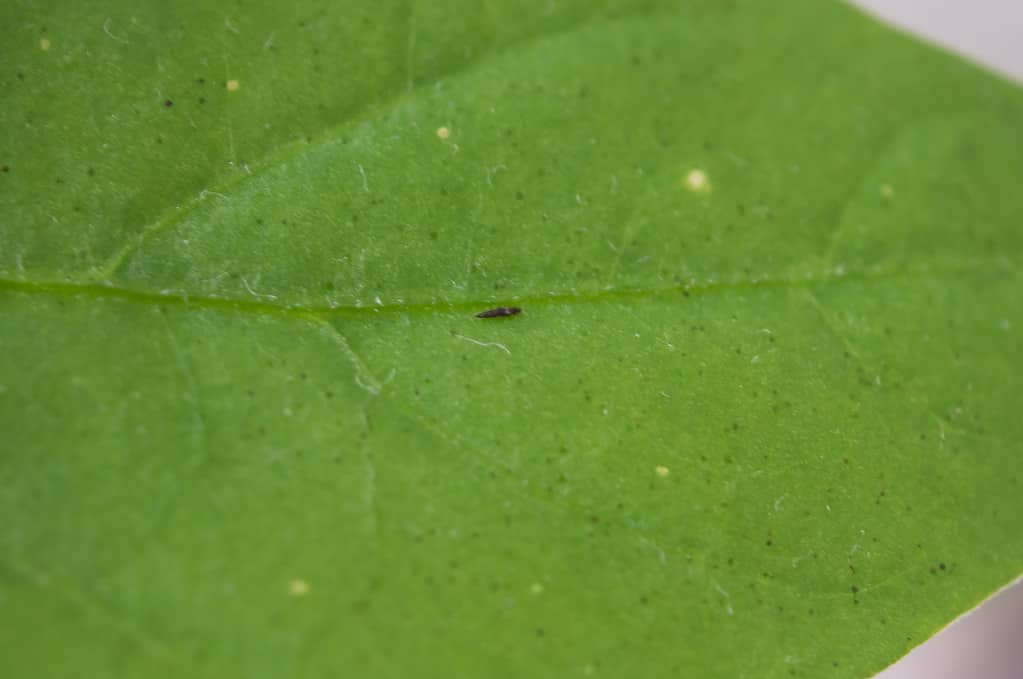
As you can see, thrips are very small. But they can be seen by the naked eye.
Thrips are small, slender insects that measure between 0.5 and 1.5 millimeters in length. They have long, narrow bodies with two pairs of narrow wings that are held close together, giving them a streamlined, tapered look. Their color ranges from yellow-brown to black, and they have two long, pointed antennae on their heads. Thrips feed on plant sap and are often found on the underside of leaves or inside flowers, sucking out the plant’s juices. They may also feed on pollen and small insects.
20 Plants That Thrips Love
The best way to control thrips is to identify them as soon as possible. Check your plants often for symptoms of thrips. If you notice thrips have damaged any of the above-mentioned plants, you should take action to limit the spread. This can include removing any affected plants, spraying with insecticidal soap, and using sticky traps to monitor the population. Thrips are attracted to hundreds of types of vegetables, houseplants, fruits, and other plants. Here are a few of their favorites.
Summary of 20 Plants Thrips Love
| Number | Plants That Attract Thrips |
|---|---|
| 1 | Alocasia |
| 2 | Calathea |
| 3 | Dracaena |
| 4 | Dieffenbachia |
| 5 | Monstera |
| 6 | Palm |
| 7 | Peace Lilly |
| 8 | ZZ Plant |
| 9 | Bergenia |
| 10 | Azalea |
| 11 | Fern |
| 12 | Gloxinia |
| 13 | Viburnum |
| 14 | Camellia |
| 15 | Gerbera Daisy |
| 16 | Chrysanthemum |
| 17 | Gladiolus |
| 18 | Rose |
| 19 | Aglaonema |
| 20 | Begonia |
How To Get Rid Of Thrips
There are a variety of methods to keep plants free from thrips infestations. These include ensuring proper sanitation, using organic pest repellents, and introducing beneficial insects and predators. Good garden hygiene is also important to prevent thrips from taking hold. Be sure to remove debris, weeds, and other vegetation that may provide a hospitable habitat for these pests. Additionally, use a steady stream of water to flush out potential pests in the soil.
Sticky Traps

Yellow sticky insect traps can help you figure out if you have a thrip problem or not.
©iStock.com/AlSimonov
Using sticky traps of various colors (white, yellow, hot-pink, and blue) placed near openings just above the crop can help to detect adult thrips. It is important to change the placement of the traps as the crop grows. Inspect the traps regularly. In certain areas, people use plants like petunias to assist in monitoring thrips and virus problems. While sticky traps can show population size and flight activity. You can use these plants to gauge feeding activity and virus issues.
Biological Methods

Amblyseius cucumeris is a predatory mite that will eat thrips for you.
©Lin, G., Guertin, C., Di Paolo, SA. et al., CC BY 4.0 – Original / License
In order to manage thrips, natural enemies such as predators, parasites, and diseases have been studied. Growers use Amblyseius cucumeris (a predatory mite) to control thrips in plants or crops. People use the Orius vicinus (the pirate bug) as a predator of thrips and generalists (such as psyllids). Another effective biological control against thrips is Hypoaspis aculeifer (another predatory mite). People use it for fungus gnat control, and it may provide some control of pupating thrips in soil or growing media. The most successful approach to managing thrips is likely to be an integrated program that avoids the use of harmful chemicals and adopts effective crop management techniques.
Chemical Methods
Some people use insecticides to battle thrips. The western flower thrips strain that invades greenhouses and indoor areas is resistant to the most common thrips insecticides. To be the most effective, you should use insecticides to target larvae and adults, as they are more susceptible than eggs and pupa.
It is possible for thrips to become resistant to insecticides, so take care not to use more than the recommended number of applications of any single chemical during the year. Use spray clusters rather than regular spraying, with three sprays being administered three to five days apart, depending on the chemical used. A different chemical group should be employed for each cluster of sprays.
Make sure to spray the underside of the leaves to ensure complete coverage. If you’ve recently removed the leaves, the area will be easier to cover with the spray. Spot treat any areas that have especially high populations of greenhouse whitefly in order to prevent their spread.
Before applying any insecticides, consider their effect on beneficial insects or mites that may be part of an integrated pest management program. Speak with a horticulture expert before using any insecticide when beneficial insects or mites are in use.
Chemical-Free Thrip Control
In order to effectively prevent or minimize the presence of thrips on plants, it is crucial to implement a range of recommended practices. Firstly, it is essential to ensure that all plants being introduced are thoroughly inspected and free from any signs of pest infestation. Check over the plant for symptoms of thrips. This careful examination will help in identifying and eliminating any potential sources of thrips before they can establish themselves.
To further enhance the protection, cover vents and doors with insect-proof netting. This physical barrier acts as an effective deterrent against thrips attempting to enter the area from outside sources. Additionally, by repairing any broken glass or torn plastic within the structure, entry sites for these pests can be minimized, reducing their chances of infiltrating the growing environment.
Maintaining cleanliness plays a significant role in preventing thrip populations from flourishing. It is crucial to remove all crop remains and weeds promptly, as these serve as potential breeding grounds for pests like thrips. You can also use fumigation or implement hot and dry conditions for an extended period as effective methods for eradicating these unwanted insects.
Furthermore, keeping areas surrounding thrip-prone plants free from weeds and flowering plants contributes significantly towards minimizing pest problems caused by thrips. Regularly mowing grass ensures that there are no additional food sources available near the greenhouse vicinity that may attract these damaging insects.
How Are Thrips Beneficial?
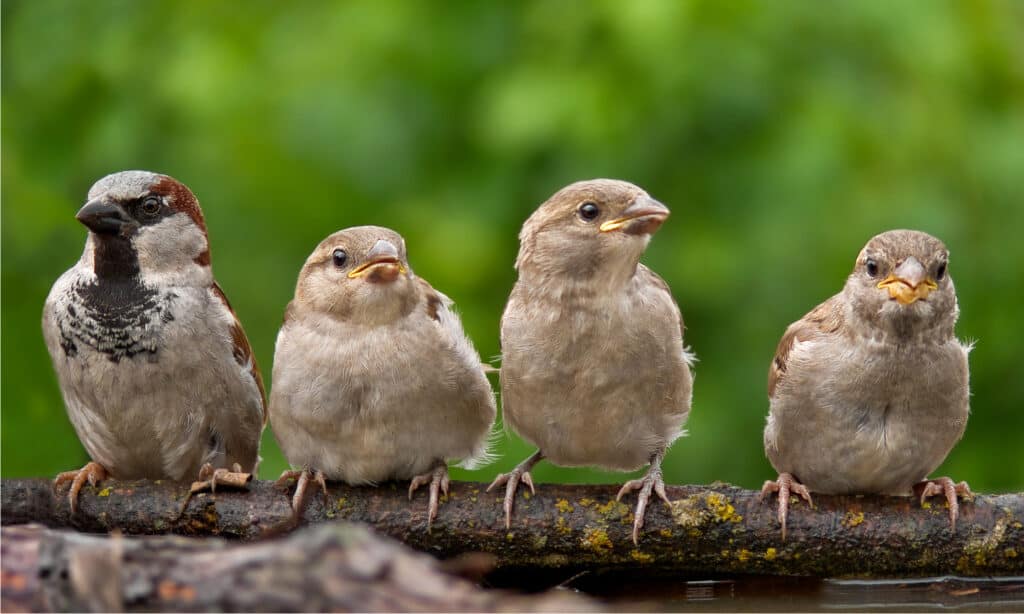
Many different types of birds and bats eat thrip insects.
©Nick Vorobey/Shutterstock.com
Thrips, despite their reputation as a nuisance to gardeners and plant enthusiasts alike, actually play a crucial role in the intricate web of life within our ecosystem. While it may be tempting to dismiss these tiny creatures as mere pests, it is important to recognize the value they bring as an essential food source for various organisms higher up in the food chain.
One significant beneficiary of thrips’ existence is the avian community. Birds rely on these minuscule insects as a vital component of their diet, particularly during breeding seasons when they require abundant nourishment to raise their young successfully. Thrips provide an easily accessible and energy-rich food source that aids in sustaining bird populations and ensuring healthy reproductive cycles.
Bats also benefit from thrips’ presence within ecosystems. These nocturnal creatures heavily rely on insects for sustenance, with many species specifically targeting small flying bugs such as thrips during their nightly hunts. By consuming considerable quantities of these tiny pests, bats not only fulfill their nutritional needs but also contribute towards maintaining ecological balance by controlling thrip populations naturally.
Furthermore, spiders form another group of beneficiaries closely linked with the presence of thrips. Many spider species actively prey upon these minute insects as part of their regular diet. The abundance of thrip populations serves as a reliable food supply for spiders while simultaneously aiding them in constructing intricate webs that capture other unsuspecting prey.
Summary of 6 Warnings Signs That You Might Have Thrips Damaging Your Plants
| Warning Sign | Description | |
|---|---|---|
| 1 | Distortion of Fruits or Young Leaves | Distorted fruits or young leaves due to thrips damage appear shriveled and curled and may have black or silver patches. The leaves may become brittle and discolored, and the fruits may become distorted in shape or size. |
| 2 | Spots on Flowers | Spots on flowers are a common symptom of thrips. They can vary in size and shape but are usually small and round. They are usually a deep brown or black color, and you will see them on both the petals and sepals. |
| 3 | Speckles of Yellow on Leaves | After thrips damage a plant, you can see the yellow speckles on leaves as small, circular spots. These spots may range from a light yellow to a brighter yellow hue, with some spots appearing to have a burnt-orange color. |
| 4 | Silvery Appearance of Older Leaves | Older leaves can have a distinctive, silvery appearance, which is caused by damage from thrip. The sucking of the thrips causes the leaves to become discolored and distorted. |
| 5 | Black Spots on Leaves | Thrip poop can be identified as tiny black dots on the leaves of a plant. This is one of the more disgusting symptoms of thrips. These black spots are a result of the thripâs excrement and can be found on the leaves in large numbers. |
| 6 | Insects Spotted Inside Flowers | Thrips are small, slender insects that measure between 0.5 and 1.5 millimeters in length. They have long, narrow bodies with two pairs of narrow wings that are held close together, giving them a streamlined, tapered look. Thrips feed on plant sap and are often found on the underside of leaves or inside flowers, sucking out the plantâs juices. |
The photo featured at the top of this post is © Oksana Lyskova/Shutterstock.com
Thank you for reading! Have some feedback for us? Contact the AZ Animals editorial team.







